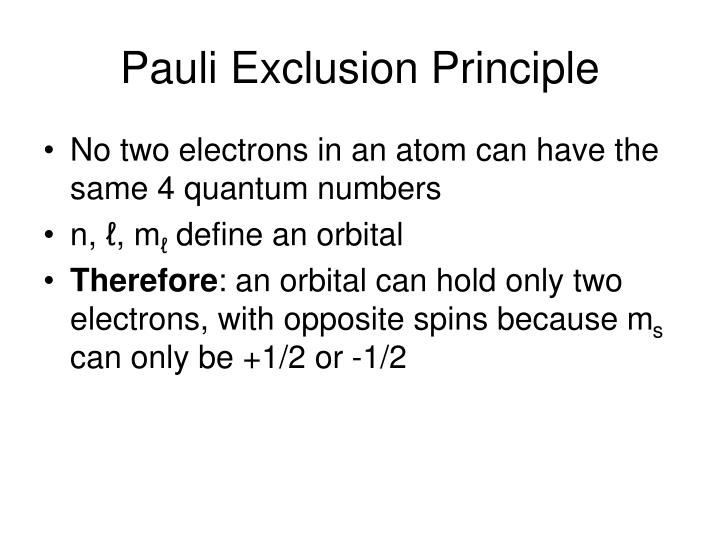

The only value l l can have is 0 (see Table 30.1 for a list of possible values once n n is known), and thus m l m l can only be 0. Consider the n = 1 n = 1 level, for example.

So we first choose n n, and then we see how many electrons can be in this energy state or energy level. Note that n n determines the energy state in the absence of a magnetic field. Since no two electrons can have the same set of quantum numbers, there are limits to how many of them can be in the same energy state. For example, the quantum numbers 2, 1, 0, − 1 / 2 2, 1, 0, − 1 / 2 completely specify the state of an electron in an atom. Since s s is always 1 / 2 1 / 2 for electrons, it is redundant to list s s, and so we omit it and specify the state of an electron by a set of four numbers n, l, m l, m s n, l, m l, m s. The quantum numbers involved were defined in Quantum Numbers and Rules as n, l, m l, s n, l, m l, s, and m s m s. Let us examine how the exclusion principle applies to electrons in atoms. (credit: Nobel Foundation, via Wikimedia Commons) He proposed the exclusion principle hypothesized the existence of an important particle, called the neutrino, before it was directly observed made fundamental contributions to several areas of theoretical physics and influenced many students who went on to do important work of their own. Thus no two electrons can have the same set of quantum numbers.įigure 30.54 The Austrian physicist Wolfgang Pauli (1900–1958) played a major role in the development of quantum mechanics. It applies to any identical particles with half-integral intrinsic spin-that is, having s = 1/2, 3/2. The Pauli exclusion principle is extremely powerful and very broadly applicable. This statement is known as the Pauli exclusion principle, because it excludes electrons from being in the same state. That is, no two electrons can be in the same state.

In 1925, the Austrian physicist Wolfgang Pauli (see Figure 30.54) proposed the following rule: No two electrons can have the same set of quantum numbers. We shall see in this section that the exclusion principle is key to the underlying explanations, and that it applies far beyond the realm of atomic physics. This systematic organization is related to the number of electrons in a neutral atom, called the atomic number, Z Z. The periodic table of the elements groups elements with similar properties into columns. The physical and chemical properties of elements are directly related to the number of electrons a neutral atom has. State the position of each element in the periodic table according to shell filling.Īll atoms except hydrogen are multiple-electron atoms.Define the position of electrons in different shells of an atom.Specify the shell and subshell symbols and their positions.Explain the Pauli exclusion principle and its application to the atom.

Define the composition of an atom along with its electrons, neutrons, and protons.By the end of this section, you will be able to:


 0 kommentar(er)
0 kommentar(er)
